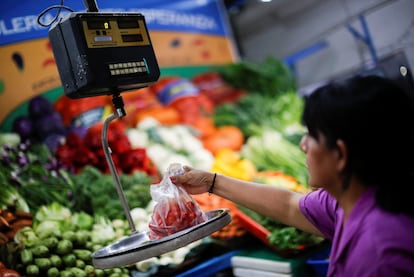The Latin American paradox: A leading food producer with expensive groceries
While the cost of feeding a family has risen everywhere, the UNDP says prices in Latin America and the Caribbean have surged the most

It’s yet another Latin American paradox. The region is a world leader in fruit, vegetable, fish and meat production, and annual food exports rake in hundreds of billions of dollars. But it’s also an expensive place to feed a family, and nearly 57 million people suffer from food insecurity. The Covid-19 pandemic exacerbated the problem and exposed vulnerabilities like the chronic underinvestment in developing its own fertilizers.
Although food inflation has surged worldwide, the rate of increase in Latin America and the Caribbean is much higher than in other regions, according to the United Nations Development Programme (UNDP). The average food inflation rate for the region reached 43.9% in September 2022, well above the 30% recorded in Asia, the region with the world’s second-highest rate.
Experts point to multiple causes: currency depreciation makes imported food more expensive, and soaring fuel prices affect transportation and distribution. Russia is a primary supplier of fertilizers to Latin America, and the war in Ukraine has disrupted their production and sale since February 2022.
The region is a net exporter of food. Latin America accounts for 14% of global agricultural and fishery production. Brazil and Argentina are using transgenic technologies (introducing foreign DNA into a host organism’s genome) to increase crop yields, while Mexican agribusiness giants have spent heavily on advertising abroad to position their products, including avocados. The Economic Commission for Latin America and the Caribbean (ECLAC) reported that the region’s annual food exports bring in $160 billion; only 13% of these exports are to other Latin American and Caribbean countries.
The ECLAC report cites these huge export numbers as one reason 49.4 million people in Latin America and 7.2 million in the Caribbean go hungry. On April 5, Mexico led a video call with six heads of state and two ministers from the region aimed at reducing tariffs to lower commodity prices. The idea was to seek “joint solutions to [food] price pressures and scarcity in the region,” as well as to “strengthen regional integration and trade.”
A recent report by the United Nations Development Program (UNDP) said, “To address a potential food security and hunger crisis, countries can implement a range of integrated policy initiatives… Agricultural support programs, such as providing farmers with seeds, fertilizer and tools, as well as training and infrastructure such as irrigation systems, can help improve food production.” The UNDP also recommended social protection policies like school meal programs, and vouchers or cash transfers to help low-income people buy nutritious food, as well as price regulation measures to ensure that food is available at affordable prices.
Sign up for our weekly newsletter to get more English-language news coverage from EL PAÍS USA Edition
Tu suscripción se está usando en otro dispositivo
¿Quieres añadir otro usuario a tu suscripción?
Si continúas leyendo en este dispositivo, no se podrá leer en el otro.
FlechaTu suscripción se está usando en otro dispositivo y solo puedes acceder a EL PAÍS desde un dispositivo a la vez.
Si quieres compartir tu cuenta, cambia tu suscripción a la modalidad Premium, así podrás añadir otro usuario. Cada uno accederá con su propia cuenta de email, lo que os permitirá personalizar vuestra experiencia en EL PAÍS.
¿Tienes una suscripción de empresa? Accede aquí para contratar más cuentas.
En el caso de no saber quién está usando tu cuenta, te recomendamos cambiar tu contraseña aquí.
Si decides continuar compartiendo tu cuenta, este mensaje se mostrará en tu dispositivo y en el de la otra persona que está usando tu cuenta de forma indefinida, afectando a tu experiencia de lectura. Puedes consultar aquí los términos y condiciones de la suscripción digital.
More information
Archived In
Últimas noticias
Welcome to the post-religion era: The idea of Christianity as the absolute truth has become obsolete
‘I thought you would like it’: The risky sexual practice popularized by TV shows and TikTok
The digitalization of tourism: ‘They promise experiences and gave us the worst possible one’
Mexican peso defies uncertainty with forecasts of a new period of stability in 2026
Most viewed
- Sinaloa Cartel war is taking its toll on Los Chapitos
- Reinhard Genzel, Nobel laureate in physics: ‘One-minute videos will never give you the truth’
- Oona Chaplin: ‘I told James Cameron that I was living in a treehouse and starting a permaculture project with a friend’
- Why the price of coffee has skyrocketed: from Brazilian plantations to specialty coffee houses
- Silver prices are going crazy: This is what’s fueling the rally











































